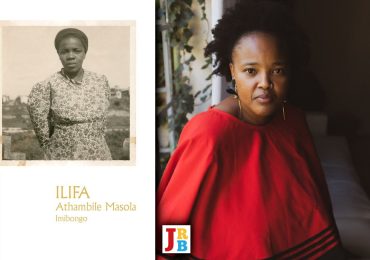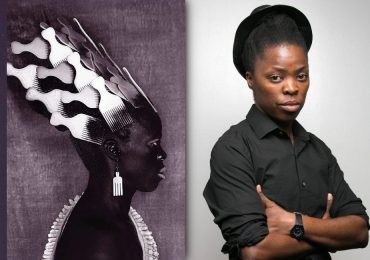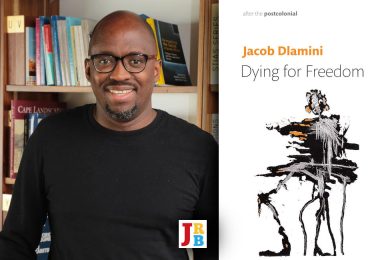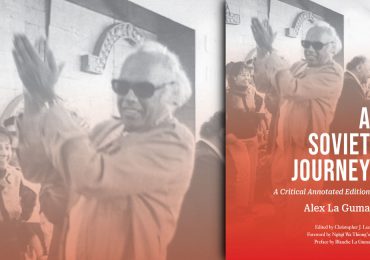On the eleventh anniversary of the Marikana massacre, which took place on on 16 August 2012, The JRB presents an excerpt from Julian Brown’s book Marikana: A People’s History.
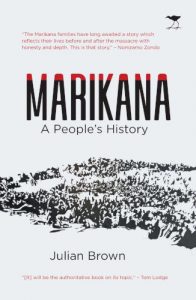
Marikana: A People’s History
Julian Brown
Jacana Media
Forty-four men died at Marikana in 2012. They are often spoken of as a group, but each had their own life and their own death. Each is still mourned by those who loved them. In this edited extract from Marikana: A People’s History, Julian Brown tells a story of just one man’s life and death.
***
‘We are who we are because of him …’
Sixty years before he was killed by the police at Marikana, Tembelakhe Mati was born in Ntabankulu, in the Eastern Cape.
He was a teenager, and still in school, when he met the woman would become his wife. Florence remembers him as a mischievous youth, full of nonsense and noise. ‘I don’t know what made me fall in love with him,’ she says. ‘First he asked me out, and I refused … I wasn’t sure about him … and he was still in school. He was young and so was I, but he wanted to marry me and take me home.’
Over time, Tembelakhe overcame her resistance. By the time he was twenty, their first child was due. At the start, life was hard: ‘He was unemployed then, and just sitting at home. I had another baby who has passed away now, and he was still unemployed … He kept looking for work but jobs were scarce … he kept going back to look for work, and having no luck.’
The Matis were not alone in this. Life was hard for many people. Ntabankulu has never been a wealthy area. Without access to jobs, most households have to find alternative means of survival. Almost two-thirds of the households in the district farm the land in one way or another, and a large minority of these households derive no income at all from their farming—in other words, they farm purely to survive. The others earn a relatively small income from odd-jobs.
In 1988, Tembelakhe moved north, to work on platinum mines in Marikana. He would work there for the next twenty-four years. As the years passed, the salary that he earned had to support not only his wife, Florence, but also their six children, his mother and three sisters.
At the start, Tembelakhe had an advantage over some of the other young men moving from the Eastern Cape to the mines: he joined his cousin, Lanford Gcotyelwa, who was already working in a mine near Rustenburg. Lanford helped him settle in, saw him regularly, and maintained their links with home and family.
This was important, because when Lanford and Tembelakhe moved to the Rustenburg area in the last years of the apartheid period, South Africa’s formal laws and informal practices effectively forced miners to live far apart from their families.
This system was symbolised, for miners, by the standard practice of housing workers in single-sex hostels. Lanford remembers his time in these dormitories: ‘Life in the hostels is not okay … there would be twenty people living in a small room. The beds, one on top of the other … All twenty of you would live like that. Hostel life was terrible.’ In saying this, he echoes the complaints of miners over many generations. Hostels were cramped, crowded, and uncomfortable. Many of them were places of conflict and violence, of gangs and quick tempers. If you were going to live in hostel, you had to learn to leave your life outside.
For these men, the everyday world was shaped by this system, which told miners where and how they worked, what they earned, how they lived, where and when they could see their families, where and when they would retire. Even after the end of apartheid, when the formal systems of forced migration and influx control were abolished, the after-effects of these systems still shaped miners’ lives in Marikana.
By 2012, at the time of the strike, the structures set up over the course of more than a century were only just starting to dissolve.
Over time, Florence was able to travel to the region. She would bring her children to visit Tembelakhe, and they would spend time together—not just the time allowed to them once a year, back at home, but time that they had chosen for themselves. Sometimes, she would spend up to four months at a stretch in Marikana.
But even so, large parts of their lives were still lived far apart—and the real revolution in their lives was the invention of cellphones and the ability to talk easily and frequently, even though they were living almost a thousand kilometres apart.
It was the phone calls that allowed his family to know something of what was happening in Marikana. At the start of the strike, in August 2012, Tembelakhe called them to say that he was watching the strike and thinking of joining it.
Florence tried to warn him of the dangers of joining in a strike, but he would have none of it. He was confident, and joked with her. ‘He mocked me for being chicken, and said that on second thought, he should not have told me [that he was striking].’
Meanwhile, Tembelakhe sketched the progress of the strike for Lanford, and shared his hopes. ‘He even went so far as saying that he wanted to take some time off but that he [also] wanted to stick around and see how far this thing would go … He never told me in detail about the strike because he was never at the helm of it …’
They spoke on the evening of 12 August, and Tembelakhe said that he had finally ‘decided to join the meeting’. Lanford remembers the call clearly, and says that: ‘I think he wanted to sit in and to ascertain what was going go. So he said to himself, let me go and find out for myself.’
They never spoke again.
On Monday 13 August, Tembelakhe Mati was part of a march of striking workers towards the K9 shaft at Lonmin’s platinum mine when they were stopped by the police.
For a while, it seemed as though a confrontation might be avoided. The police were negotiating with the miners, and they seemed to be about to reach an agreement. But then the lead officer received a phone call, and the atmosphere changed. In the minutes afterwards, someone in the police group fired a tear gas canister at the crowd, then stun grenades—and chaos erupted all around the scene.
In this chaos, the police and some of the striking mineworkers clashed violently. Two police officers and three miners were killed in the clouds of dust and teargas.
Tembelakhe Mati was one of these men.
It is clear he tried to escape the clash. When the police opened fire, he ran. He split from the crowd, and moved towards some nearby shacks—homes where he might have hoped to evade the police, or where he might have found shelter.
But the shacks offered neither shelter, nor safety. The police fired towards them.
As he ran, he was hit. He began to bleed. His legs gave way, and he collapsed near the shacks, about two hundred metres away from the clash. As he fell, his body was marked by vicious wounds: bullet holes in his thigh and buttocks, scars across his face, and scratches on his elbow where he fell to the hard ground.
He died there, where he fell.
Afterwards, his body was taken to the mortuary, but his family was not notified. They did not know he was dead, not for ages, not until after the news of the massacre reached them days later. His body sat in the mortuary for a week.
The circumstances of Tembelakhe Mati’s death still cast a shadow in Ntabankulu.
Years afterwards, his oldest daughter summed up what she knew about him:
‘He died fighting for money in Marikana. He was very much loved by us. We adored him … We are who we were because of him … Our father put us through school. Our home depended on him for everything. As it is now, we have nothing to eat …’
She was clear that her family and her neighbours blame the police for Tembelakhe’s death: ‘We are very disgusted by the police. It does not matter that some of them had nothing to do with it. As long as it’s a policeman, I am disgusted by him because the reason my father is lying where he is, is because of them …’
For them, the memory of his life is still bound up with the horror of his death.
~~~
- Julian Brown is Associate Professor of Political Studies at Wits University. He is author of The Road to Soweto: Resistance and the Uprising of 16 June 1976 and South Africa’s Insurgent Citizens: On Dissent and the Possibility of Politics.
~~~
Publisher information
‘The Marikana massacre was and is a major event in South Africa’s recent labour and political history. This text draws upon a rich interview base to offer a detailed narrative and a persuasive analysis of the miners’ actions informed by insider voices, that is, by participants. [It] will be the authoritative book on its topic.’—Tom Lodge, University of Limerick
On 16 August 2012, the South African police shot dead thirty-four men and injured hundreds more, bringing to an end a week-long strike at the Lonmin platinum mine in Marikana.
None of the murdered people posed a threat to any police officer.
Existing studies of this nation-shaping and internationally significant event have often overlooked the experiences and perspectives of the striking miners themselves. Now, for the first time, the men’s lives—and deaths—are put at the centre of the story.
Placing the strike in the context of South Africa’s long history of racial and economic exclusion, explaining how the miners came to be in Marikana, how their lives were ordinarily lived and the substance of their complaints, Julian Brown shows how the strike developed from an initial gathering into a mass movement of more than three thousand workers.
Drawing on interviews with strikers and their families, he tells the stories of those who embarked on the strike, those who were killed, and the attempts of the families of the deceased to identify and bury their dead. Brown also provides a comprehensive review of the subsequent Commission of Inquiry and points to the politics of solidarity with the Marikana miners that have emerged since.

